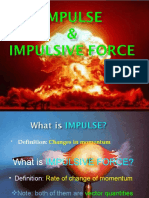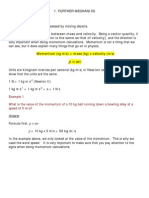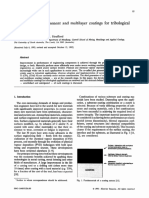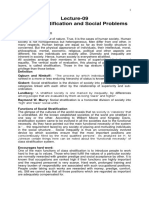MODULE MCO 2 (PHYSICS Wednesday 25/3/2020 9.30 - 10.30) Analysing Impulse and Impulsive Force Impulse and Impulsive Force
MODULE MCO 2 (PHYSICS Wednesday 25/3/2020 9.30 - 10.30) Analysing Impulse and Impulsive Force Impulse and Impulsive Force
Uploaded by
Zalini AbdullahCopyright:
Available Formats
MODULE MCO 2 (PHYSICS Wednesday 25/3/2020 9.30 - 10.30) Analysing Impulse and Impulsive Force Impulse and Impulsive Force
MODULE MCO 2 (PHYSICS Wednesday 25/3/2020 9.30 - 10.30) Analysing Impulse and Impulsive Force Impulse and Impulsive Force
Uploaded by
Zalini AbdullahOriginal Description:
Original Title
Copyright
Available Formats
Share this document
Did you find this document useful?
Is this content inappropriate?
Copyright:
Available Formats
MODULE MCO 2 (PHYSICS Wednesday 25/3/2020 9.30 - 10.30) Analysing Impulse and Impulsive Force Impulse and Impulsive Force
MODULE MCO 2 (PHYSICS Wednesday 25/3/2020 9.30 - 10.30) Analysing Impulse and Impulsive Force Impulse and Impulsive Force
Uploaded by
Zalini AbdullahCopyright:
Available Formats
MODULE MCO 2 ( PHYSICS Wednesday 25/3/2020 9.30 -10.
30)
2.6 ANALYSING IMPULSE AND IMPULSIVE FORCE
Impulse and impulsive force
1. The change of momentum
Impulse is …………………………………………………………………………….
2. The large force that acts over a short period of time during
Impulsive force is ………………………………………………………………………
collision and explosion.
…………………………………………………………………………………………
3. Formula of impulse and impulsive force:
Refer, F = ma It is known that a= (v–u)/t
Therefore, F = m( v – u)
t
So, Ft = mv – mu , Unit = N s
Ft is defined as impulse, which is the change in momentum.
F = mv – mu ,
t
Ft = mv – mu Unit : newton (N)
F is defined as impulsive force which is the rate of change of momentum over
the short period of time
Example 1; v u
wall
If ; u = 10 m s-1 , v = - 10 m s-1 , m = 5 kg and t = 1 s
Impulse, Ft = and impulsive force, F =
Example 2; v u
Wall with a soft surface
If ; u = 10 m s-1 , v = - 10 m s-1 , m = 5 kg and t = 2 s
5(10) - (- 5(10)) 100 = 100 N
Impulse, Ft = and impulsive force, F =
= 100 Ns 1
4. The relationship between time of collision and impulsive force.
Impulsive force , F µ 1 / t
Therefore, F decreases
5(10) - when the time of collision increases ( refer to examples
(- 5(10)) 100 = 50) N
= 100 Ns 2
Impulsive force , F µ 1 / t
Therefore, F decreases when the time of collision increases ( refer to examples )
Exercise 2.6
1. A force of 20 N is applied for 0.8 s when a football player throws a ball from the
sideline. What is the impulse given to the ball?
Fimpulse = Ft
= 20 x 0.8
= 16.0 Ns
2. A stuntman in a movie jumps from a tall building an falls toward the ground. A large
canvas bag filled with air used to break his fall. How is the impulsive force reduced?
1. A large canvas bag will increase the time of collision.
2. When the time of collision increase the impulsive force will decrease.
Weight
1. as the gravitational force acting on the object.
The weight of an object is defined ……………………………………………………..
2. For an object of mass m, the weight can be calculate as :
weight, W = mg
where, g = acceleration due to gravity.
Example : The mass of a helicopter is 600 kg. What is the weight of the helicopter
when it land on the peak of a mountain where the gravitational field is
9.78 N kg-1? W = mg
= 600 x 9.78
= 58 68 N
You might also like
- Potential Energy Mastering PhysicsDocument23 pagesPotential Energy Mastering PhysicsLea Dominique Mangubat Fariola0% (1)
- Grade 8 Activity Sheets Quarter 1 Week 1-2Document34 pagesGrade 8 Activity Sheets Quarter 1 Week 1-2Lance Elarcosa100% (1)
- A Literature Review of Use of Recycled Concrete Aggregates PDFDocument61 pagesA Literature Review of Use of Recycled Concrete Aggregates PDFyyanan111875% (4)
- 2.7 Impulse & Impulsive ForceDocument7 pages2.7 Impulse & Impulsive ForcenurularissaNo ratings yet
- LESSON 2.6. Impulse, Impulsive Force and SafetyDocument7 pagesLESSON 2.6. Impulse, Impulsive Force and Safetychekgu_2007No ratings yet
- 1 Linear MomentumDocument50 pages1 Linear MomentumChristine Joy ManzanillaNo ratings yet
- Physics-Lesson 2.6impulse, Impulsive Force and Safety Features in VehiclesDocument7 pagesPhysics-Lesson 2.6impulse, Impulsive Force and Safety Features in VehiclesRais RahimiNo ratings yet
- Physics 111Document59 pagesPhysics 111rolandmichael461No ratings yet
- Momentum, Impulse and Energy: Pre-Reading: KJF 9.1 and 9.2Document27 pagesMomentum, Impulse and Energy: Pre-Reading: KJF 9.1 and 9.2lady jazzmineNo ratings yet
- MomentumDocument5 pagesMomentumCara DoddsNo ratings yet
- Dynamics PDFDocument35 pagesDynamics PDFLukeman IssahNo ratings yet
- IJSO Part-8Document1 pageIJSO Part-8SadguruNo ratings yet
- Lecture Notes 8 - Momentum and ImpulseDocument7 pagesLecture Notes 8 - Momentum and ImpulseJezManuel04No ratings yet
- ImpulseDocument15 pagesImpulseCheah Chong ShengNo ratings yet
- Impulse MomentumDocument19 pagesImpulse MomentumAhmed Raza100% (1)
- Mass and Inertia: Dynamics 1Document11 pagesMass and Inertia: Dynamics 1Joe West100% (2)
- OH - DSE - 2025-PHY X1 PHY - EnergyDocument16 pagesOH - DSE - 2025-PHY X1 PHY - EnergySeanNo ratings yet
- PHY 111 Lecture Note 21-11-2023Document54 pagesPHY 111 Lecture Note 21-11-2023TimmyNo ratings yet
- Force, Work, Power & Energy (1) IcseDocument62 pagesForce, Work, Power & Energy (1) IcsesachiduthNo ratings yet
- Impulse Force X Time I F (T)Document1 pageImpulse Force X Time I F (T)Rosita IntesNo ratings yet
- Effects of ForceDocument38 pagesEffects of ForceAz MY100% (1)
- Ding Thethe Effects of A ForceDocument18 pagesDing Thethe Effects of A Forcenik mohamad solehinNo ratings yet
- Physics Lesson Plan 08 - Impulse and Momentum PDFDocument6 pagesPhysics Lesson Plan 08 - Impulse and Momentum PDFKim MacarasigNo ratings yet
- Unit 1: Conservation Laws: Lesson 7: Momentum and ImpulseDocument54 pagesUnit 1: Conservation Laws: Lesson 7: Momentum and ImpulsebevinjNo ratings yet
- 2.4 MOMENTUM-IMPULSe PDFDocument71 pages2.4 MOMENTUM-IMPULSe PDFsanad boshehNo ratings yet
- 2 Impulse and MomentumDocument11 pages2 Impulse and MomentumRyan Moncada BasantaNo ratings yet
- Unit 2 Motion and Forces Study Guide - KEYDocument5 pagesUnit 2 Motion and Forces Study Guide - KEYnadja mujaNo ratings yet
- Physics Friction ModuleDocument7 pagesPhysics Friction ModuleFRANCES VISAYANo ratings yet
- 2012 Dynamics Lect4Document19 pages2012 Dynamics Lect4Wee Chee LimNo ratings yet
- Phy 111 Linear MomentumDocument36 pagesPhy 111 Linear Momentumajohnson.2400065No ratings yet
- LawsofMotion Paper 04Document7 pagesLawsofMotion Paper 04Brajesh GautamNo ratings yet
- 1-d Momentum and Impulse - KeyDocument6 pages1-d Momentum and Impulse - KeyAli Ali AliNo ratings yet
- (Revisi) LKPD Group 2 Project Base LearningDocument18 pages(Revisi) LKPD Group 2 Project Base LearningRizka Utari RahmadaniNo ratings yet
- S4 CH 7 Momentum 22-23Document32 pagesS4 CH 7 Momentum 22-23qjg5zshjsrNo ratings yet
- Form 4 Physics Chapter 2.5-2.9 - Teacher'sDocument14 pagesForm 4 Physics Chapter 2.5-2.9 - Teacher'sPavithiran100% (1)
- 2.2d Newton S 2nd Law and 3rd LawDocument57 pages2.2d Newton S 2nd Law and 3rd LawJiwoo SeoNo ratings yet
- A.2.2 Momentum and ImpluseDocument36 pagesA.2.2 Momentum and ImplusezmedendoNo ratings yet
- 4 - Momentum N ImpulseDocument33 pages4 - Momentum N ImpulseShivaranjini RamendranNo ratings yet
- Mechanics Sec04 Full Notes02 PDFDocument7 pagesMechanics Sec04 Full Notes02 PDFMDR PRAPHUNo ratings yet
- 013 Lecture 12 Part 1 (Linear Momentum)Document22 pages013 Lecture 12 Part 1 (Linear Momentum)Paidamoyo MlamboNo ratings yet
- Work and EnergyDocument31 pagesWork and EnergyEllie Pama PastranaNo ratings yet
- Medical Physics ١Document57 pagesMedical Physics ١Mohammed Yousif AbdualjabbarNo ratings yet
- Impulse MomentumDocument18 pagesImpulse MomentumJulius CodillaNo ratings yet
- M09 Knig9404 Ism C09 PDFDocument38 pagesM09 Knig9404 Ism C09 PDFnorma_jeannNo ratings yet
- Lesson 7. Linear Momentum and ImpulseDocument6 pagesLesson 7. Linear Momentum and ImpulselopomNo ratings yet
- MOMENTUMDocument19 pagesMOMENTUMAlleah Joy DelandaoNo ratings yet
- Newton's First LawDocument18 pagesNewton's First LawjoeNo ratings yet
- Chapter 10 Momentum, System of Particles, and Conservation of MomentumDocument22 pagesChapter 10 Momentum, System of Particles, and Conservation of MomentumSriram ArumugamNo ratings yet
- Pdfa2 8Document1 pagePdfa2 8aizatNo ratings yet
- Chapter3 Forces and MotionDocument77 pagesChapter3 Forces and Motionyue yueNo ratings yet
- 2.6 Analysing Impulse & Impulsive ForceDocument12 pages2.6 Analysing Impulse & Impulsive ForceAisha Chunsha Cassiopeia100% (1)
- Linear Momentum and CollisionsDocument7 pagesLinear Momentum and CollisionsFaris AlasmariNo ratings yet
- MIT16 07F09 Lec12 PDFDocument11 pagesMIT16 07F09 Lec12 PDFletter_ashish4444No ratings yet
- Momentum Student NotesDocument17 pagesMomentum Student NotesabdulfcNo ratings yet
- Impulse-Momentum RelationDocument2 pagesImpulse-Momentum RelationMartha Glorie Manalo WallisNo ratings yet
- Laws of MotionshshDocument21 pagesLaws of Motionshshpatel2rraj1249No ratings yet
- Topic 2.4 - Momentum and ImpulseDocument38 pagesTopic 2.4 - Momentum and ImpulseKhánh NguyễnNo ratings yet
- Last Discussion Work Power and Energy Impulse and MomentumDocument16 pagesLast Discussion Work Power and Energy Impulse and Momentumnamyaj2215No ratings yet
- Impulse MomentumDocument19 pagesImpulse MomentumMiss RonaNo ratings yet
- Impulse and Impulsive ForceDocument16 pagesImpulse and Impulsive ForcediaNo ratings yet
- 2 - Simple PendulumDocument15 pages2 - Simple Pendulumكمبيوتر العائلهNo ratings yet
- Student'S Module Physics Module Form 4 Chapter 2: Force and MotionDocument23 pagesStudent'S Module Physics Module Form 4 Chapter 2: Force and MotionZalini AbdullahNo ratings yet
- 4.4 Understanding The Gas Law: Property of Gas Volume, VDocument6 pages4.4 Understanding The Gas Law: Property of Gas Volume, VZalini AbdullahNo ratings yet
- Faster. Rate of Energy Transfer: 4.1: Understanding Thermal EquilibriumDocument6 pagesFaster. Rate of Energy Transfer: 4.1: Understanding Thermal EquilibriumZalini AbdullahNo ratings yet
- 4.2: Understanding Specific Heat CapacityDocument6 pages4.2: Understanding Specific Heat CapacityZalini AbdullahNo ratings yet
- 3.1 Newton's Law of Universal GravitationDocument4 pages3.1 Newton's Law of Universal GravitationZalini AbdullahNo ratings yet
- InertiaDocument10 pagesInertiaZalini AbdullahNo ratings yet
- MCO 3 (30/3-3/4/2020) Reinforcement Chapter 2 Part A: Objective QuestionsDocument5 pagesMCO 3 (30/3-3/4/2020) Reinforcement Chapter 2 Part A: Objective QuestionsZalini AbdullahNo ratings yet
- Trial 18 P 3Document11 pagesTrial 18 P 3Zalini AbdullahNo ratings yet
- MGT613Document19 pagesMGT613Taimoor Sultan100% (3)
- Ancient West Philo Notes CompleteDocument47 pagesAncient West Philo Notes CompletesingcosweindinglasaNo ratings yet
- Lesson 4.1 - Rectangular Coordinate SystemDocument67 pagesLesson 4.1 - Rectangular Coordinate SystemAlthea Ruth AlesnaNo ratings yet
- Study Vine RobotDocument11 pagesStudy Vine RobotGinoux GuillaumeNo ratings yet
- The Evolution of Bizarre Structures' in Dinosaurs: Biomechanics, Sexual Selection, Social Selection or Species Recognition?Document15 pagesThe Evolution of Bizarre Structures' in Dinosaurs: Biomechanics, Sexual Selection, Social Selection or Species Recognition?Manuel PérezNo ratings yet
- 16Sp-Quiz 2 SolutionDocument1 page16Sp-Quiz 2 SolutionKalisetty SwethaNo ratings yet
- Review of Multicomponent and Multilayer Coatings For TribologicalDocument11 pagesReview of Multicomponent and Multilayer Coatings For TribologicalFernando Spanholi TelesNo ratings yet
- T1 Math 7 Worksheet 1 5C Multiplication and Division of IntegersDocument2 pagesT1 Math 7 Worksheet 1 5C Multiplication and Division of IntegersNesney YoutubeNo ratings yet
- Food Safety Knowledge and Practices Among Fresh Coconut VendorsDocument6 pagesFood Safety Knowledge and Practices Among Fresh Coconut VendorsSamantha Jesica SalesNo ratings yet
- A Fracture Mechanics Analysis of The Texture of Fried Potato Crust PDFDocument7 pagesA Fracture Mechanics Analysis of The Texture of Fried Potato Crust PDFRomaric OuetchehouNo ratings yet
- Rouag 2018Document19 pagesRouag 2018أيــمـنNo ratings yet
- Color BlindnessDocument4 pagesColor BlindnessShehroz KhanNo ratings yet
- Cambridge International General Certificate of Secondary EducationDocument16 pagesCambridge International General Certificate of Secondary EducationDipto RoyNo ratings yet
- Composite Materials in Aerospace Applications PDFDocument10 pagesComposite Materials in Aerospace Applications PDFYustinus KrisnaNo ratings yet
- Lecture-09 Social Stratification and Social ProblemsDocument5 pagesLecture-09 Social Stratification and Social ProblemsfafasdfsdfasNo ratings yet
- Ucv Academic PensumDocument2 pagesUcv Academic PensumScribdTranslationsNo ratings yet
- Zone Sensor LT460 - Installation ManualDocument16 pagesZone Sensor LT460 - Installation ManualLuis Alberto Huamán MalcaNo ratings yet
- My Fiance Is in Love With My Little Sister - 01Document148 pagesMy Fiance Is in Love With My Little Sister - 01hanimoltyfanNo ratings yet
- Testing Hypothesis With One SampleDocument10 pagesTesting Hypothesis With One SampleStephanie Danielle HizoleNo ratings yet
- CIIF-CFC21CallforProposalsENGLISH 1 3 ID55493Document18 pagesCIIF-CFC21CallforProposalsENGLISH 1 3 ID55493Shema MayanjaNo ratings yet
- Ghost Links in CatiaDocument4 pagesGhost Links in CatiaMelvin B EkboteNo ratings yet
- Week 5Document7 pagesWeek 5mylene neviarNo ratings yet
- Physical, Ergonomic and Psychosocial HazardsDocument64 pagesPhysical, Ergonomic and Psychosocial HazardsPatricia GalorioNo ratings yet
- Summary of Grades JHSDocument76 pagesSummary of Grades JHSDonabel CariosNo ratings yet
- Ey CGF Top of Mind Report June 2022Document40 pagesEy CGF Top of Mind Report June 2022Taskin Reza KhalidNo ratings yet
- Bpho SPC 2023 QPDocument12 pagesBpho SPC 2023 QPsanjay.vullisNo ratings yet
- Humanoid RobotsDocument28 pagesHumanoid Robotsneethu_20No ratings yet
- DLL - Science 5 - Q1 - W7Document7 pagesDLL - Science 5 - Q1 - W7Maritess SilvestreNo ratings yet

































































































